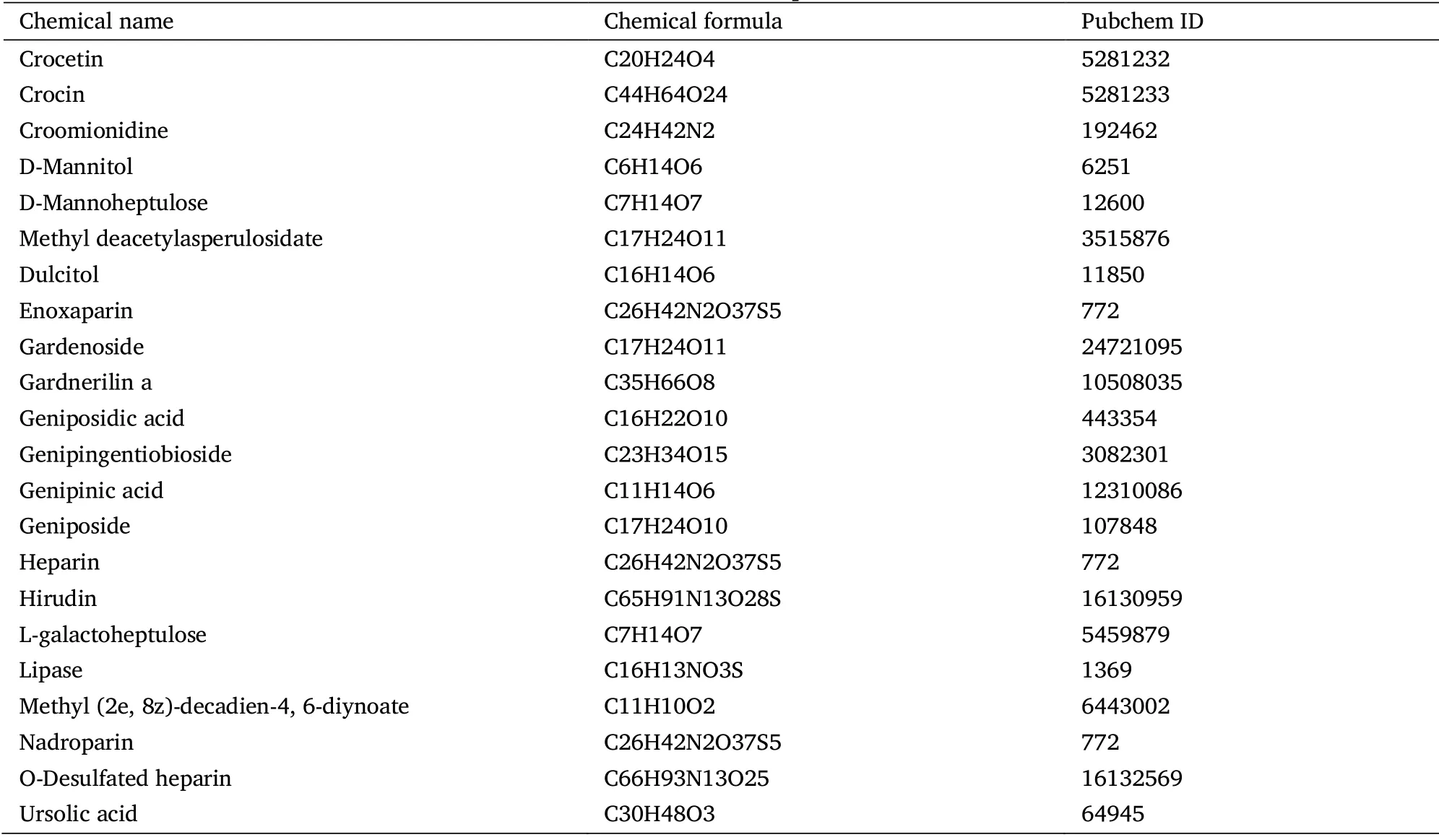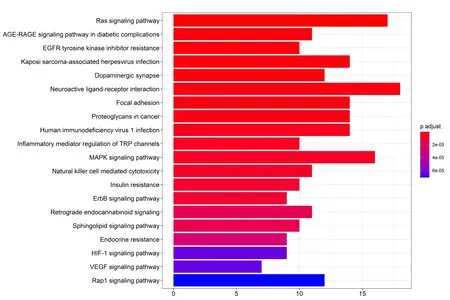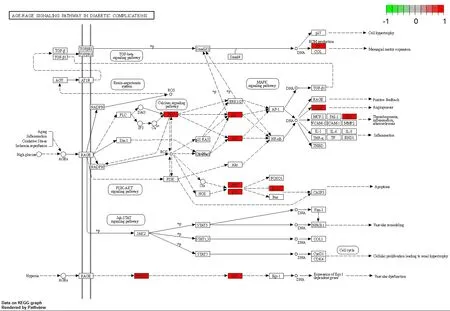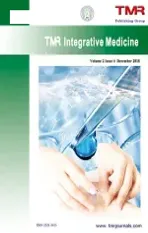Mechanism of Shuizhi (Hirudo nipponica Whitman) for chronic kidney disease based on network pharmacology
2022-06-14YangPingXiaoChenYunZhangJueYingChenChunLiLongQiangLinJiWeiQiuJunLinMoWeiSHiYongXiangXie
Background
The prevalence rate of CKD among Chinese adults exceeds 10% [1].CKD has become the ninth leading cause of death in developed countries, indicating that CKD is a significant public health problem.CKD has no known cure and can only slow down its progression.The course of CKD is lingering and challenging to heal, becoming stasis over time.Traditional Chinese medicine believes that CKD is the symptom of spleen-kidney qi deficiency.Damp turbidity and blood stasis are their pathological basis.Blood stasis is both a pathological product and a pathogenic factor throughout the development of CKD.Therefore, the method of promoting blood circulation and removing blood stasis should be carried out throughout the treatment.
Shuizhi (
Whitman) tastes acrid and salty, and it has a mild property, with the effects of clearing and activating the channels and collaterals, and so on.It is an essential medicine for promoting blood circulation and removing blood stasis.Studies have shown that Shuizhi has anti-platelet aggregation, prevention of thrombosis, anti-infection, anti-inflammatory analgesic, anti-cancer metastasis, and other functions.The pharmacological effects of Shuizhi are mainly divided into two categories: one is the active component of the coagulation system, and the other is the active component of protease inhibitors.Shuizhi and its extracts have been clinically reported to treat CKD by improving inflammation levels and slowing down renal tubule and renal interstitial fibrosis in patients with CKD.Shuizhi and its extracts have been widely used in the clinical treatment of CKD.Although some experiments and experts have proved the components and mechanism of their therapeutic effects, it is still not completely clear.
Network pharmacology is an interactive network based on the concept of “drug-gene-target-disease”, which views the intervention and effect of drugs on disease networks from a systematic and comprehensive perspective to reveal the complex mechanism of drug action on human beings.This study’s holistic and systematic characteristics resonate with the traditional Chinese medicine’s analysis of the synergistic mechanism of drugs acting on diseases through multiple components, pathways and targets from the perspective of syndrome differentiation and holistic concept.Therefore, systematic analysis of chemical components and action mechanism of Shuizhi in treating CKD based on network pharmacology can provide a scientific basis for the action mechanism of Shuizhi in CKD.
Materials and methods
The chemical composition of Shuizhi
This study relied on the TCMID (http://119.3.41.228:8000/tcmid/) to search the keyword “Shuizhi”, and a total of 35 compounds of Shuizhi were obtained.
The target of Shuizhi
We input the SMILE numbers corresponding to the 22 compound molecules finally obtained into SwissTargetPrediction(http://www.swisstargetprediction.ch/) and STITCH(http://stitch.embl.de/cgi/input.pl) to query the corresponding targets.
Another guy scored. By this time, the entire team had joined the cheering, Go, Harry, go Harry! This was surely the longest distance Harry had ever run. He was panting as he headed for third and another guy crossed home. The right fielder s throw was critical, and it was pretty good, but the third baseman muffed it. The ball scooted past him out of play. The rule: one base on an overthrow17 that goes out of play. Harry, exhausted18, kept the push on as best he could.
Identification of disease targets
Cytoscape 3.7.2 software analyzes 100 targets intersecting Shuizhi compound targets and CKD disease-related genes, constructing a compound-target interaction network graph.There are 123 nodes in this interaction network graph (including 100 intersecting targets and 21 compounds) and 638 edges.In the network diagram, the big and red represents the disease, the purple represents the CKD disease target, the green represents the traditional Chinese medicine-Shuizhi,and the light blue represents the related compounds of the Shuizhi.The degree of a node represents the number of connections between this node and the other nodes.The larger the degree’s value, it may indicate that a certain compound of the Shuizhi plays an essential role in the occurrence and development of CKD.Genipinic acid, genioisidic acid, gardenoside, and enoxaparin can be seen from Figure 1, and four compounds all connected 13 targets in the network diagram.
Standardization and mapping of molecular targets for drugs and diseases
Use the Venn diagram function of the R language to take the intersection of the Shuizhi compound target and the CKD disease-related target.Meanwhile, Venney diagram was drawn to visualize the relationship between them.
Shuizhi compound-target interaction diagram
A total of 35 leech compounds were retrieved.The action target could not be predicted, because the corresponding chemical structure formula and SMILE number were not found for 13 of them.Therefore,13 compound molecules with an unknown structure were removed,and 22 effective compounds were finally obtained, which is as shown in Table 1.
PPI network construction
One day the Queen was travelling through that part of the country, and had her little daughter, who was a princess, with her. All the people, amongst them Karen too, streamed towards the castle, where the little princess, in fine white clothes, stood before the window and allowed herself to be stared at. She wore neither a train nor a golden crown, but beautiful red morocco shoes; they were indeed much finer than those which the shoemaker’s wife had sewn for little Karen. There is really nothing in the world that can be compared to red shoes!
The corresponding target of this compound molecule, lipase, did not find a relevant target in swiss target prediction.The remaining 21 compound molecules obtained a total of 147 targets, and after deleting the duplicate values, the unique value of the target was 98.
There is a huge difference between growing older and growing up. If you are nineteen years old and lie in bed for one full year and don t do one productive thing, you will turn twenty years old. If I am eighty-seven years old and stay in bed for a year and never do anything I will turn eighty-eight. Anybody can grow older. That doesn t take any talent or ability. The idea is to grow up by always finding the opportunity in change.
GO function enrichment analysis and KEGG pathway enrichment analysis
Use the RSQ Lite function of the R language to combine the screened PPI core target with the ID corresponding to the org.Hs.eg.db conversion gene, and use the Clue-GO in Cytoscape to perform GO analysis on the core target after conversion.KEGG pathway analysis is performed on the core target using the cluster profiler of the R language.
Results
Screening of Shuizhi compounds
Cytoscape 3.7.2 software can perform data parameter analysis and biological function annotation and convert it into an optical network through data combination.The above intersection targets were imported into Cytoscape to construct the compound - target interaction network diagram.
The PPI data comes from String (https://string-db.org/), a database for predicting PPI.Set the search condition “Homo sapiens” and enter it into a multi-protein manner to construct a protein interaction network diagram.And perform topological analysis to screen core targets.

Traditional Chinese medicine target screening
Finally, they entered the clothing section and headed for a rack full of Ralph Lauren Polo shirts. Yes! I could already picture myself standing12 in the fairway, contemplating13 my approach shot, while the others in my group commented on my impeccable taste.
The Shuizhi compound-target interaction map
Retrieving “chronic kidney disease” from the GeneCards database(https://www.genecards.org/), a total of 13, 439 genes related to CKD targets were obtained.In order to improve the efficiency of data research, we set a correlation threshold more significant than 10 and removed those with low correlation scores.3, 587 related gene targets were obtained according to the pathogenesis of CKD.

Construction of PPI network
The leech protein interaction network diagram was obtained from String database and imported into Cytoscape3.7.2 to construct a 98-node, 1154 edge weighted PPI network diagram (Figure 2).Cytoscape analyzed the topology of the PPI network and screened out 17 critical targets in the PPI network, suggesting that these targets may be critical targets for Shuizhi to treat CKD, as is shown in Table 2.


GO function enrichment analysis and KEGG pathway enrichment analysis
The main contents of GO analysis include cytological components,molecular functions, and biological functions.“Biological processes”,“Cellular component”, and “Molecular function”, select the items related to CKD according to the corresponding parameters of the above GO and KEGG pathway analysis results, carry out further analysis according to the ascending order of
value, upload the analysis results of the first 20 pathways to Omic Share cloud platform,and select the corresponding parameters for data visualization processing.Clue-GO in Cytoscape3.7.2 software apps were used to enrich and analyze the core targets (100).As shown in Figure 3, 101 enrichment results of biological processes mainly involve alkaloid reaction process, ligand activation transcription factor activity process, the positive regulation process of endothelial cell migration,nuclear receptor agonist, regulation of phospholipase C activity,hormone biosynthesis process, regulation of vascular endothelial growth factor receptor signaling pathway and so on.As shown in Figure 4, 20 enrichment results of cell composition mainly involve MHC class I protein complex, the composition of the presynaptic membrane, composition of dopaminergic synapses, neuron projection membrane, macroglutaminergic synapses and so on.In Figure 5, 51 enrichment results were obtained, including catecholamine binding,nuclear receptor activation, JUN enzyme activity, transmembrane receptor protein tyrosine kinase activity, proteasine kinase activity,glycosphingolipid binding, opioid receptor activity, and so on.
The sky was as black as ink, it was thundering and lightening, and the sea was tossing in great waves as high as church towers and mountains, and each had a white crest36 of foam



We found that the clinical application of Shuizhi can effectively alleviate the development of CKD and improve proteinuria, renal fibrosis, and microinflammation in patients with CKD.Therefore, we screened the related components of Shuizhi through the database,obtained potential targets through target fishing, and then integrated the database to screen out the related targets of CKD.Based on the matching results between potential Shuizhi targets and CKD targets,we constructed a PPI network to analyze the interaction between these targets, screened the central targets through topology, explored and analyzed the possible mechanism of Shuizhi on CKD by using GO gene function analysis and KEGG pathway enrichment analysis.




Discussion
KEGG screened 96 related signal pathways (
< 0.05,
< 0.05),as shown in Figure 6, Figure 7, Figure 8.Among them, 7 pathways(Table 3) were most related to CKD, such as the AGE/RAGE signaling pathway (hsa04933), MAPK signaling pathway (hsa04010), HIF-1 signaling pathway (hsa04066), VEGF signaling pathway (hsa04370),PI3K/Akt signaling pathway (hsa04151) and NF-kappa B signaling pathway (hsa04064).
The occurrence of CKD is closely related to disease progression and inflammatory levels.The decrease in renal filtration rate, the increase of circulating inflammatory factors, oxidative stress, malnutrition, and ecological destruction of intestinal flora further promote the development of inflammation [10]. At the same time,microinflammation and chronic hypoxia have been proved to lead to renal fibrosis through various signal pathways [11].
Studies have shown that Shuizhi contains 22 main active components and 147 related target genes.After mapping with CKD target genes, 100 target genes for treating CKD were screened out,showing that Shuizhi has “multi-component-multi-target”characteristics in treating CKD.According to the “drug-disease” target interaction network diagram, we got four hub compounds: genipinic acid, genioisidic acid, garden-side, and enoxaparin.Enoxaparin is the first choice anticoagulant for the clinical treatment of cardiovascular diseases and deep vein thrombosis.It mainly acts by inhibiting Xa factor and thrombin and is often used in patients with end-stage kidney disease with thrombosis risk [12].Geniposide can improve the inflammatory state by reducing the expression and release of TNF-α and interleukin-6 (IL-6) in mouse macrophages induced by lipopolysaccharide (LPS).At the same time, it can reduce the whole blood viscosity, inhibit the release of endothelin and inhibit thrombosis induced by adenosine diphosphate (ADP) [14].Geniposide is an active ingredient with anti-apoptosis and anti-inflammatory properties, which can alleviate the apoptosis of rat renal podocytes induced by LPS and the occurrence of proteinuria by activating autophagy mediated by Ras/Raf/MEK/ERK [15].Geniposide can also inhibit TLR4/MyD88 signal transduction and NLRP3 inflammatory body activation in hyperuricemia mice, reduce the production of pro-inflammatory cytokines, and inhibit the expression of TGF-1 β and TNF-α from improving the symptoms of kidney diseases [16].These active ingredients have antithrombotic, anti-inflammatory, and anticoagulant effects on Shuizhi, delaying CKD progress.
According to GO analysis of drug-disease intersection targets, 17 key targets, including ESR1, VEGFA, and EGFR, were screened out from 100 common targets of Shuizhi and CKD.Therefore, it suggested that the potential mechanism of Shuizhi in treating CKD may be related to its biological process of coagulation reaction, vascular endothelial growth factor, protease activity, and inflammatory reaction.Shuizhi participates in anticoagulation and antithrombosis directly by regulating complement and coagulation cascade reaction,acting on different targets in the coagulation process, inhibiting serine proteinogenic transformation, inhibiting platelet aggregation or tissue fibrinolysis pathway.At the same time, it can also promote platelet activation and produce fibrinogen to mediate platelet adhesion and repair blood vessels when the blood vessel wall is injured [17].The vascular endothelial growth factor signal transduction pathway promotes the proliferation of vascular endothelial cells and is related to vascular permeability.Liu Na, et al.found that Shuizhi can alleviate the damage of podocytes in focal segmental glomerulosclerosis by down-regulating the expression of VEGF, effectively improving proteinuria and alleviating kidney diseases [18].Li Fengwen and other studies have shown that Shuizhi protects the intima of blood vessels by enhancing the motor function of blood vessels and reducing the permeability of blood vessels, thus restoring the repair of vascular endothelium in blood stasis model animals [19].
The turnstile clicked and Josh hung on to his souvenir ticket stub like he had just won the lottery4! Climbing the ramps5 to the upper elevation6 seemed more an adventure than a chore, as we got to the upper-level seats of the true fans
KEGG pathway enrichment is estimated by analyzing the results of biological processes, regulation of molecular functions, cell composition, and signal pathways of regulation.The gene function of Shuizhi in treating CKD may be related to improving oxidative stress(AGE/RAGE signaling pathway, NF-kappa B signaling pathway),delaying renal fibrosis (MAPK signaling pathway, PI3K/Akt signaling pathway), improving microcirculation (HIF-1 signaling pathway), and alleviating vascular endothelial hyperplasia (VEGF signaling pathway).In recent years, the incidence of diabetic nephropathy in CKD has increased yearly.D-ribose can induce the formation and activation of the NLRP3 inflammatory body in podocytes through the AGEs/RAGE signaling pathway, which causes related glomerular damage, and it is one of the essential triggering mechanisms of diabetic nephropathy [20].Its downstream is closely related to NF-κ B, VGEF, TGF-β 1, and other genes, which is an important signal pathway in the formation and progression of diabetic nephropathy[21].Wang Chuncheng, et al.used spironolactone to inhibit AGEs/RAGEs axis, up-regulate sirtuin-3 protein, nicotinamide adenine dinucleotide phosphate oxidase 2 (NOX-2) and their related intracellular oxidative stress, and improve the attenuation of endothelial dysfunction in 5/6 nephrectomy renal failure model [22].Therefore, it is speculated that Shuizhi may delay CKD development by regulating this signaling pathway.Studies have confirmed that MAPK kinase phosphorylation is closely related to tubular epithelial cell-myofibroblast transdifferentiation (TEMT).When cells are stimulated by outside, MAPK is activated, which transmits phosphorylated groups downstream, promotes P38MAPK activation,increases p-P38MAPK protein expression, and then promotes the TEMT process [23].Zhang Guorui, et al.acted on the kidney tissue of UUO rats with active vitamin D3, inhibited the activation of P38MAPK, and delayed the occurrence of TEMT, thus reducing renal fibrosis and protecting renal function [24].Therefore, the delay of renal fibrosis in treating CKD with Shuizhi may be related to this pathway.Chronic ischemia and hypoxia are essential to promote CKD progression and fibrosis.Chronic renal failure leads to ischemia and hypoxia, which will significantly increase HIF-1 expression and induce atrophy or expansion of renal tubular epithelial cells [25].It has been reported that Panax notoginseng, a drug for promoting blood circulation and removing blood stasis, can delay the progress of CKD by regulating the expression of HIF-1 α and VEGF [26].VEGF is an essential mitogen for endothelial cells, which has been proved to promote endothelial cell proliferation, induce angiogenesis and even enhance the permeability of small blood vessels [27].VEGF can promote epithelial cells forming vascular rings, affecting glomerular filtration function.VEGF is the target gene of HIF-1 α (hypoxia reactive protein), which enhances the transcription level of VEGF.Ischemia and hypoxia cause glomerular filtration function to be blocked and increase proteinuria emission [28].Studies have shown that Danhong injection can improve renal microcirculation, reduce urinary protein, protect renal function and alleviate the process of CKD by down-regulating serum TGF-β 1, VEGF, MCP-1, and ANG ⅱ[29].PI3K/AKT signaling pathway is a crucial signal transduction pathway in nuclear cells and plays an essential role in CKD.Its activation affects the proliferation of mesangial cells and the secretion of extracellular matrix and participates in the process of renal interstitial fibrosis in the UUO rat model [30].Studies have shown that inhibiting the phosphorylation of PI3K and AKT protein has a protective effect on the kidney of rats with chronic renal failure and delays renal interstitial fibrosis [31].Therefore, Shuizhi may be therapeutic in CKD by regulating the above pathways.The team’s previous research found that Shuizhi can significantly improve hemorheology, remove cytokines closely related to inflammatory reaction and immune response, intervene in the expression of ApoE protein, and improve blood stasis syndrome at the molecular level,thus, delaying renal interstitial fibrosis, protecting renal function and improving patients’ quality of life [32–33].Hirudin can inhibit the inflammatory reaction, regulate fibrosis-related proteins and extracellular matrix, and reduce the apoptosis of renal tubular epithelial cells, thus, inhibiting the fibrosis of renal tissue and renal tubular epithelial cells and delaying renal interstitial fibrosis in the UUO rat model [34].
Through network pharmacology, our study predicted the target of Shuizhi’s chemical composition and discussed its potential mechanism in treating CKD.The target mechanism may focus on the coagulation process, vascular endothelial growth factor, protease activity, and inflammatory reaction.Through the analysis of specific signaling pathways, we found that the AGE/RAGE signaling pathway, MAPK signaling pathway, HIF-1 signaling pathway, VEGF signaling pathway,and PI3K/Akt signaling pathway are the main possible pathways for Shuizhi to treat CKD.Therefore, it is speculated that the potential mechanism of Shuizhi in treating CKD is multi-target and multi-pathway efforts, with a direct or indirect synergistic effect.However, there are still many deficiencies in this study.Firstly, the current research on the active components of Shuizhi mainly focuses on the macromolecules of proteins and polypeptides, such as hirudin,heparin, amino acids, and other substances.While the active components of Shuizhi included in the database analyzed in this paper are mainly small molecules, so they have certain limitations.Second,network pharmacology is a database-based analysis that depends on retrieving the compound molecules included in the database.There are few databases related to Shuizhi, and many macromolecular substances are not included, so the databases need to be further improved.Third, the completeness of data collection and the criteria for screening active ingredients need to be further accurate.These deficiencies provide essential information and ideas for further study on the mechanism of Shuizhi.
1. Liu ZH, Li GS, Zhang L, et al.Executive summary: clinical practice guideline of chronic kidney disease-mineral and bone disorder (CKD-MBD) in China.
(
).2019;5(4):197–203.https://doi.org/10.1159/000500053
2. Obrador GT, Levin A.CKD hotspots: challenges and areas of opportunity.
.2019 May;39(3):308–314.https://doi.org/10.1016/j.semnephrol.2019.02.009
3. Wu YC, Xu Y, Lu ZY, et al.Symptom management for chronic kidney disease patients based on the theory of traditional Chinese medicine over spleen and kidney relationship: clinical experience from professor Huang Chunlin.
.2016;18(6):968–971.(Chinese)http://dx.chinadoi.cn/10.11842/wst.2016.06.005
4. Lyu F, Li W.Discussion on the pathogenesis of chronic kidney disease from the viewpoint of deficiency and blood stasis and turbidity and toxicity.
.2019;39(10):1482–1484.(Chinese)http://dx.chinadoi.cn/10.16367/j.issn.1003-5028.2019.10.036 6
5. Liu X, Gao MF, Kong Y.Bioactive constituents and pharmacological effects of Leech.
.2017;24(1):76–80.(Chinese)http://dx.chinadoi.cn/10.19526/j.cnki.1005-8915.20170117
6. Zhong GY, Wang YL.Clinical observation on the efficacy of Hirudo Powder in the treatment of chronic kidney disease.
.2019;11(19):130–132.(Chinese)http://dx.chinadoi.cn/10.3969/j.issn.1674-9308.2019.19.056
7. Yi JG.Effects of SanhuangShuizhi Decoction treatment on TNF-a and IL-6 in chronic renal failure patients.
.2013;35(10):7–8.(Chinese)http://dx.chinadoi.cn/10.3969/j.issn.1000-0704.2013.10.004
8. Hopkins AL.Network pharmacology: the next paradigm in drug discovery.
.2008;4(11):682–690.https://doi.org/10.1038/nchembio.118
9. Zhang B, Wang X, Li S.An integrative platform of TCM network pharmacology and its application on a herbal formula,Qing-Luo-Yin.
.2013;2013:456747.https://doi.org/10.1155/2013/456747
10.Liu YR, Liu DD, Zhang HX.Research progress on the role of hypoxia inducible factor in chronic kidney disease.
.2020;13(2):203–206.(Chinese)https://t.cnki.net/kcms/detail?v=2pO3nMf6htic-JO5tyFji2G0 UQzcvrJhj8yLdpH4DzjGlemYs-wcCu7PUFWmcviLfJJUK1360yK QF5iSRnrvY-6pGHXdUersOTJJXdz1rCEQI1nRr9lSXFuG4F_RDA Wr&uniplatform=NZKPT
11.Wu YN, Chen WD.Research progress of microinflammation in chronic kidney disease.
.2019;35(1):122–124.(Chinese)http://dx.chinadoi.cn/10.16833/j.cnki.jbmc.2019.01.052
12.Lai S, Coppola B.Use of enoxaparin in end-stage renal disease.
.2013;84(3):433–436.https://doi.org/10.1038/ki.2013.163
13.Shi QH, Cao JJ, Fang L, et al.Geniposide suppresses LPS-induced nitric oxide, PGE 2 and inflammatory cytokine by downregulating NF-κB, MAPK and AP-1 signaling pathways in macrophages.
.2014;20(2):298–306.https://doi.org/10.1016/j.intimp.2014.04.004
14.Zhang HY. Study on cardiovascular effects of geniposide/baicalin and its application in drug coating of vascular stent.Southwest Jiaotong University,2014.(Chinese)https://kns.cnki.net/kcms/detail/detail.aspx?dbcode=CDFD&d bname=CDFDLAST2015&filename=1015348755.nh&uniplatf orm=NZKPT&v=OvsVdyFyWb-ae5v-TmHQlS4-DQlLGxxQttqW SbEmyoFjy4t_9zqZIpXqt2fPKdOa
15.Li X, Ma A, Liu K. Geniposide alleviates lipopolysaccharide-caused apoptosis of murine kidney podocytes by activating Ras/Raf/MEK/ERK-mediated cell autophagy.
.2019;47(1):1524–1532.https://doi.org/10.1080/21691401.2019.1601630
16.Chao L, Zhou HN, Zhang RR, et al.Anti-hyperuricemic and nephroprotective effect of geniposide in chronic hyperuricemia mice.
.2019;61:103355.https://doi.org/10.1016/j.jff.2019.05.011
17.Ouyang LD, Hu XS, Niu M, et al.Study on the mechanism of Shuizhi promoting blood circulation and removing blood stasis based on network pharmacology.
.2018;43(9):1901–1906.(Chinese)https://doi.org/10.19540/j.cnki.cjcmm.2018.0065
18.Liu N, Wang LF, Yang X, et al.Intervention effect of Shuizhi on podocyte injury in focal segmental glomerulosclerosis mediated by vascular endothelial growth factor.
.2019;48(6):345–347.https://d.wanfangdata.com.cn/periodical/hljzyy201906248
19.Li FW, Zhang LS, Liu H, et al.Protective effect of Shuizhi, Salvia miltiorrhiza and their compound on vascular endothelial cells in rats with blood stasis.
.2001(10):55–58.(Chinese)https://kns.cnki.net/kcms/detail/detail.aspx?dbcode=CJFD&d bname=CJFD2001&filename=ZGZY200110021&uniplatform=NZKPT&v=m2jAUHm9v5VuOwcIchY_77ZQG0Dcj1MwApdh 5aCDIHy7QskZ10yxnDBoXyKDCJW2
20.Hong JN, Li GB, Zhang QH, Ritter J, Li Ww, Li PL.D-Ribose induces podocyte NLRP3 inflammasome activation and glomerular injury via AGEs/RAGE pathway.
.2019;7:259.https://doi.org/10.3389/fcell.2019.00259
21.Yang CM, Yang ZX, Ma XL.Mechanism of AGEs-RAGE signaling pathway in diabetic nephropathy and research progress of traditional Chinese medicine.
.2019;34(9):1864–1868.https://doi.org/10.3389/fcell.2019.00259
22.Wang CC, Lee AS, Liu SH, Chang KC, Shen MY, Chang CT.Spironolactone ameliorates endothelial dysfunction through inhibition of the AGE/RAGE axis in a chronic renal failure rat model.
.2019;20(1):351.https://doi.org/10.1186/s12882-019-1534-4
23.Liu C, Chen FZ, Han XC, Xu H, Wang YG.Role of TGF-β1/p38 MAPK pathway in hepatitis B virus-induced tubular epithelial-myofibroblast transdifferentiation.
.2014;7(11):7923–7930.https://pubmed.ncbi.nlm.nih.gov/25550833/
24.Zhang GR, Jia L, Yang XP, Zhao J, Tao L.Effect of active vitamin D3 on the P38 mitogen activated protein kinase signaling pathway in rat with unilateral ureteral obstruction.
.2020;40(5):1036–1039.http://dx.chinadoi.cn/10.3969/j.issn.1005-9202.2020.05.045
25.Sun XL, Feng GZ, Hou GC, Lei ZK, Shang XM.Effect of HIF-1 on anemia of the chronic renal failure rats induced by 5/6 nephrectomy kidney.
.2016;47(3):223–227.http://dx.chinadoi.cn/10.13753/j.issn.1007-6611.2016.03.007
26.Tao ZH.Effect of Panax notoginseng on HIF-1 α, VEGF expression and renal protection in rats with chronic renal failure.Kidney Disease Professional Committee of Chinese Association of Integrated Traditional Chinese and Western Medicine.Summary of papers of 2018 Annual Meeting of Kidney Disease Professional Committee of Chinese Association of Integrated Traditional Chinese and Western Medicine.2018:794.https://doi.org/10.13753/j.issn.1007-6611.2016.03.007
27.Ren F, Wu KX, Yang Y, Yang YY, Wang YX, Li J.Dandelion polysaccharide exerts anti-angiogenesis effect on hepatocellular carcinoma by regulating VEGF/HIF-1α expression.
.2020;11:460.https://doi.org/10.3389/fphar.2020.00460
28.Li L, Liu Y, Xia F, Zhang QY, Xie MS.Effect of Huanglian Wendan Decoction on expressions of TGF-β1 and VEGF in kidney of chronic renal failure model rat.
.2019;34(10):2169–2174.(Chinese)http://dx.chinadoi.cn/10.16368/j.issn.1674-8999.2019.10.502
29.Wang LP, Wu G, Liao ZM, Zhao CZ, Huang YH.Effect of Danhong Injection combined with Valsartan on efficacy and related factors in patients with chronic renal failure.
.2018;24(7):1078–1081.(Chinese)http://dx.chinadoi.cn/10.3969/j.issn.1006-6233.2018.07.006
30.Yang J, Wang C, Zhu TT, et al.The Expression of PI3K/Akt pathway in chronic renal failure rats’ nephridial tissue and the effects of “Meliorated Renal Faiure Decotion”.
.2015;16(9):763–766.(Chinese)https://d.wanfangdata.com.cn/periodical/zgzxyjhsbzz2015090 08
31.Yu Y, Zhao WC, Xu Y, Yuan F.Effect of berberine hydrochloride on renal interstitial fibrosis in rats with chronic renal failure and its effect on PTEN/PI3K/AKT signaling pathway.
.2020;22(3):26–30.(Chinese)http://dx.chinadoi.cn/10.13194/j.issn.1673-842x.2020.03.008
32.Xie YX, Shi W, Long CL, Lan F, Xie LP.Proteomic study of the rat model on intervention of leeches against IgA nephropathy based on iTRAQ technology.
.2019;19(3):202–207.(Chinese)http://dx.chinadoi.cn/10.3969/j.issn.1671-2390.2019.03.010
33.Xie YX, Shi W, Long CL, Lan F, Meng LF, Xie LP.The Mechanism of action of Leech in IgA nephropathy rats was studied based on proteomics methods.
.2018;19(12):1048–1051.(Chinese)http://dx.chinadoi.cn/10.3969/j.issn.1009-587X.2018.12.005
34.Xie YX, Lan F, Zhao J, Shi W.Hirudin improves renal interstitial fibrosis by reducing renal tubule injury and inflammation in unilateral ureteral obstruction (UUO) mice.
.2020;81:106249.https://doi.org/10.1016/j.intimp.2020.106249
